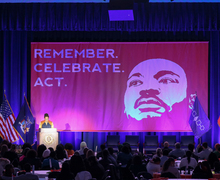New BioInspired leaders aim to increase interdisciplinary research and diversity at SU
Isabella Flores | Asst. Photo Editor
Jay Henderson, the new director of the BioInspired Institute at Syracuse University, said he hopes to expand the institute's initiatives through increased interdisciplinary collaboration.
Get the latest Syracuse news delivered right to your inbox.
Subscribe to our newsletter here.
When Jay Henderson and Heidi Hehnly first got involved with the BioInspired Institute at Syracuse University, it was known as the BioMaterials Institute. Now, after four years of working to establish a strong base of fundamental and applied research, the BioInspired Institute is ready to expand collaborations and initiatives to address societal issues.
As the new director and associate director, Henderson and Hehnly are leading the BioInspired Institute through emerging global challenges like artificial intelligence and the COVID-19 pandemic, in addition to fostering research focus groups and efforts to increase diversity in STEM at SU.
“One thing we’re excited to do now is build from that foundation that was set up in the first few years, where now we can think about how can we really optimize or maximize the impact that this fundamental research can have?” Henderson said.
The BioInspired Institute is a center for research and development regarding biological systems and smart materials to address needs in health, medicine and other scientific areas. The institute is housed in Bowne Hall and has additional laboratory space in the Life Sciences Complex.
While BioInspired members are primarily from the biology, physics, chemistry and engineering fields, both Henderson and Hehnly stressed the institute’s goal of interdisciplinary collaboration.
With the opportunities it offers, the institute’s new leadership is aiming to increase undergraduate student involvement, particularly with students in the S.I. Newhouse School of Public Communications, Hehnly said, to help future communications professionals become familiar with scientific writing.
Henderson said he also wants to cultivate relationships with students in the Maxwell School of Citizenship and Public Affairs as well as the Martin J. Whitman School of Management to help inform people about science in the context of social and political issues.
With growing public distrust of scientific data in recent years, Henderson said scientists must take on the responsibility of conveying their work and why it’s important to society, which BioInspired aims to do.
“These kinds of transdisciplinary interactions are really important to help us educate the public and gain their trust and come up with scientific understanding and with products of our work, the technologies that can help society,” Henderson said. “It’s critical that we’re not just doing the research, but that we’re also having these interactions so that we can impact the world.”
Henderson and Hehnly took on their new roles in the institute in July. Lisa Manning, the previous director of BioInspired, said she’s excited to see what new goals and initiatives the two will bring. Henderson served as the associate director when Manning was director.
“Jay has a lot of exciting ideas and I want to give him space to lead the Institute in the direction that he sees is exciting,” Manning said.
Hehnly, who is the Renee Crown university professor of mathematics and science and an associate professor of biology, said she led an initiative called Bio Art, which illustrates the institute’s main goal of facilitating work between different fields of study.
Hehnly coordinated a Bio Art mixer, where scientists and artists discussed their work, which eventually helped the BioInspired Institute start a Bio Art studio course. The class includes students from SU’s College of Visual and Performing Arts, as well as students from majors like biology, physics and engineering, to explore biomaterial usage in art projects.
“We want to create these collaborative spaces to create novel and impactful research and broaden that out to art spaces,” Hehnly said. “While they are installations and art pieces, they still sometimes have a fundamental scientific question to them.”
Many of the Bio Art projects, Hehnly said, have centered on areas like the environment, health and disease, and researchers work to create pieces that communicate to broad audiences about it.
In recent years, researchers at BioInspired have also worked to address prevalent health concerns, like metastatic cancers, congenital diseases and most recently, the COVID-19 pandemic, Manning said.
Alison Patteson and Jen Schwarz, both SU physics professors involved with BioInspired, worked on a COVID-19 treatment that is currently in clinical trials, Hehnly and Manning said. The project focuses on the mechanics of how a virus is taken up by a cell, Manning said.
“There’s this exciting area at the intersection of thinking about the mechanical and material properties of living systems,” Manning said. “The idea is you can actually alter the mechanical properties of the cell surface, and it makes it harder for cells to uptake the COVID virus.”
Another current global issue the institute is involved with is the advent of artificial intelligence technology and its usages in the STEM field. Hehnly said the institute has already seen AI incorporated into a Bio Art project, where a researcher used AI to generate images based on his drawings and designs.
“I find it a very compelling argument about how AI is a tool that can advance art and our education, where we can learn more and faster and go beyond what we’re already creating,” Hehnly said.
In Henderson’s efforts to increase diversity within the BioInspired Institute and STEM research at SU as a whole, he said reaching out to undergraduates early on in their college careers has been essential. When he began reaching out, he said, he wanted to make sure no students were left excluded or unsupported at any point in their time at SU.
The BioInspired Institute now offers summer research opportunities for students coming into their first year on campus, especially targeted to students coming to SU from underrepresented or underserved communities, Henderson said.
Henderson said BioInspired is also partnered with Hampton University in Virginia and North Carolina A&T University, both of which are historically Black universities, to further efforts of increasing diversity.
To support BioInspired researchers at SU, the institute has three focus groups — development and disease, form and function and smart materials. While anyone with a research interest can join BioInspired, Manning said researchers are typically postdoctoral associates, graduate students or faculty members.
In addition to the focus groups and research support, the institute also offers professional development and training for graduate students and postdoctoral associates, Manning said. The training encompasses soft skills like graphic design, project management and entrepreneurship for participants to use throughout their careers, she said. Another event the institute offers, an annual symposium, will be held on Oct. 19 this year.
Henderson said that with its new leadership, BioInspired can continue to add value to SU as it progresses its diversity, collaboration and career development initiatives in addition to the research at its core.
“That’s kind of the next phase I see — we’ve got a great foundation, it took a lot of work over the first few years to kind of get everything in place, and now, what can we do to be more distinctive and more unique and add more to it?” Henderson said.
Published on September 10, 2023 at 9:35 pm
Contact Stephanie: spwright@syr.edu






